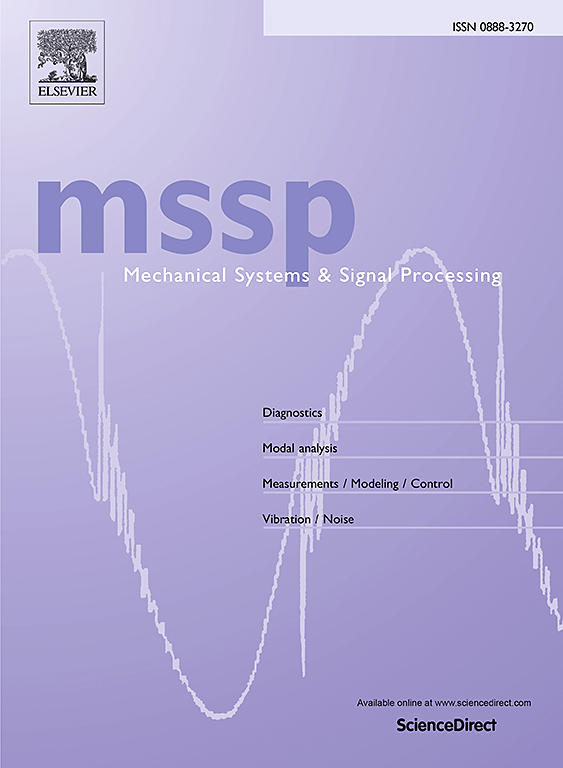A novel data-driven K-SVD transferrable baseline method for multi-damage identification for composite fuselage panels
IF 8.9
1区 工程技术
Q1 ENGINEERING, MECHANICAL
引用次数: 0
Abstract
This paper presents a novel, scalable, data-driven, and transferrable baseline framework for damage detection and localization in large, complex composite structures operating under in-service conditions, such as varying temperatures. The proposed approach addresses a key challenge in the adoption of ultrasonic guided wave Structural Health Monitoring (SHM) for damage detection in large structures: the need to collect baseline measurements.
The proposed framework detects damage in composite fuselage panels by creating a dictionary of pristine data from simpler structural components, i.e. flat composite coupon panels and mono-stringer elements. By utilizing shapelets generated at these lower structural levels, the methodology can be extended to more complex geometries, accommodating variations in temperature, material properties, sensor configurations, and specimen sizes, making it suitable for structures in service. The framework is built around the K-SVD algorithm, which efficiently captures the most representative shapelets while significantly reducing computational time. The reliability and accuracy of the algorithm are validated using pristine coupon data to minimize false alarms, and the approach is then scaled to address more complex curved fuselage panels. Furthermore, the framework incorporates a reliability-based threshold into the K-SVD algorithm for the first time, establishing a detectability threshold for this transferrable baseline method and enabling both damage detection and severity assessment. The effectiveness and robustness of the methodology are demonstrated experimentally using data from large 5-meter curved fuselage panels subjected to varying temperatures and multiple damage scenarios. The results show a true positive rate of 0.951 and a false negative rate of 0.944 for damage detection in the curved fuselage panels within a temperature range of 25°C to 50°C.
一种新的数据驱动K-SVD可转移基线方法用于复合材料机身面板多损伤识别
本文提出了一种新颖的、可扩展的、数据驱动的、可转移的基线框架,用于在服役条件下运行的大型复杂复合材料结构的损伤检测和定位,如变温。提出的方法解决了采用超声导波结构健康监测(SHM)进行大型结构损伤检测的关键挑战:需要收集基线测量值。该框架通过创建简单结构部件的原始数据字典来检测复合材料机身面板的损伤,例如平面复合材料面板和单弦元件。通过利用这些较低结构水平产生的小颗粒,该方法可以扩展到更复杂的几何形状,适应温度、材料特性、传感器配置和试样尺寸的变化,使其适用于服役结构。该框架是围绕K-SVD算法构建的,该算法有效地捕获最具代表性的shapelets,同时显着减少了计算时间。该算法的可靠性和准确性使用原始的优惠券数据进行验证,以最大限度地减少假警报,然后将该方法扩展到更复杂的弯曲机身面板。此外,该框架首次将基于可靠性的阈值整合到K-SVD算法中,为这种可转移基线方法建立了可检测阈值,从而实现了损伤检测和严重程度评估。实验结果表明,该方法的有效性和鲁棒性得到了验证,实验数据来自于受不同温度和多种损伤情景影响的大型5米弯曲机身面板。结果表明,在25℃~ 50℃温度范围内,弯曲机身面板损伤检测的真阳性率为0.951,假阴性率为0.944。
本文章由计算机程序翻译,如有差异,请以英文原文为准。
求助全文
约1分钟内获得全文
求助全文
来源期刊

Mechanical Systems and Signal Processing
工程技术-工程:机械
CiteScore
14.80
自引率
13.10%
发文量
1183
审稿时长
5.4 months
期刊介绍:
Journal Name: Mechanical Systems and Signal Processing (MSSP)
Interdisciplinary Focus:
Mechanical, Aerospace, and Civil Engineering
Purpose:Reporting scientific advancements of the highest quality
Arising from new techniques in sensing, instrumentation, signal processing, modelling, and control of dynamic systems
 求助内容:
求助内容: 应助结果提醒方式:
应助结果提醒方式:


